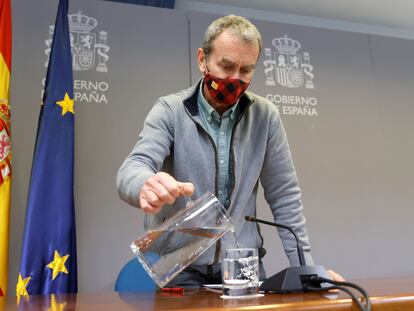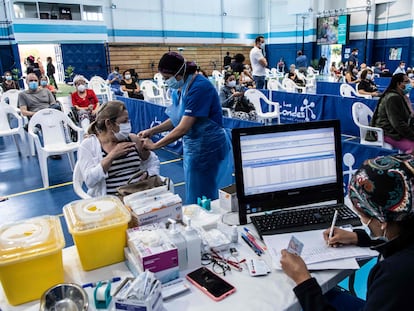How organizational problems in Spain are impeding the administration of Covid-19 vaccines
The immunization of essential workers and the over-80s got going this week with a number of complications over appointments, which are slowing down the campaign. Last week just 75% of received doses were injected
Organizational problems are hampering Spain’s Covid-19 vaccination drive. While the country at one point was administering nearly all of the vaccines that were delivered, this is no longer the case. As more doses have arrived and the Oxford-AstraZeneca vaccine has been integrated into the program, the difference between the number of jabs received and those administered has grown. Healthcare representatives say this is largely due to organizational problems. While the first phase of the vaccination drive targeted staff and residents in care homes, as well as frontline health workers, who are easy to locate and bring together, the next stage has been extended to essential workers under the age of 55 and people 80 years and over, which is presenting logistical challenges.
Although the regions – which are responsible for handling the response to the pandemic and the Covid vaccination drive – have launched this next phase at different speeds, the overall trend is clear. On February 2, Spain had administered 94% of all Covid doses it had received. This figure fell to 90% on February 9 and to 87% on February 23. Last week, it dropped again to 75%. The figures from last week are the most recent as Spain has not yet had time to administer the last shipment of Covid vaccines: 886,880 new doses, the largest delivery to date. It won’t be known until next Tuesday whether Spain’s vaccination drive is slowing down or picking up after starting the inoculation of the next priority groups.
The difference between the number of doses delivered and those administered is greatest with the AstraZeneca vaccine, which was approved after the candidates from Pfizer and Moderna. The Spanish Health Ministry decided to only use the AstraZeneca vaccine on people between the ages of 18 and 55, due to the lack of clinical evidence of its effectiveness in older demographics. This meant it needed to push forward a new priority group: essential workers, such as teachers, law-enforcement officers and firefighters, under the age of 55. On February 23 (the last day with comparable data), Spain had administered 95.5% of the doses from Pfizer, 70.8% from Moderna and just 33.7% from AstraZeneca.
According to María José García, the spokesperson of the nursing union Satse, with “the easiest part” of the vaccination drive now over, more challenges are starting to appear. “[Vaccinating] the residents [of care homes], who all live in the same place, and healthcare workers has been faster because they are easy to locate in the very centers where they are vaccinated. Now, with adults who need daily assistance but are not in care homes, and essential workers, it is more complicated. In the first case, for logistical reasons: you have to go to their homes, and in the second, for the sheer volume,” she explains.
But the situation varies greatly in each of Spain’s 17 regions. Although there is a national strategy, some regional governments have decided to overlap different priority groups more than others, or change the order completely. In Madrid, for example, healthcare workers received the jab before many care home residents. And there are also differences with respect to the vaccination of essential workers. According to data from Satse, regions such as Castilla y León and Aragón have not begun to inoculate this priority group, while the Canary Islands have started the campaign with police officers, and Galicia with teachers. Other regions are vaccinating different groups of essential workers at the same time.
Complications
Launching the drive is a slow process, which may explain the delay in administering the AstraZeneca vaccine, and once it begins, it is also subject to complications. In Galicia, for example, the first day of the campaign to vaccinate essential workers was “chaotic,” according to some workers, with a shipment delay leading to large lines at hospitals. Unions also said that teachers showed up who did not have an appointment, while others were called to get the vaccine although they were over the age of 55.
The vaccination drive of essential workers in Spain’s Basque Country was also criticized. In a survey by the Basque Medical Union, 53.2% of respondents said it was “terrible” and 26.9% “bad.” Only 4.1% of the doctors surveyed had a positive opinion.
On Thursday, Madrid began vaccinating essential workers in the Wanda Metropolitano stadium and people 80 years and over in healthcare centers. But the process has been mired in confusion, with nursing and doctors unions complaining of “improvisation and chaos.” These unions say the region sent out an out-of-date list of patients to be vaccinated, which included the names of the deceased. Satse also says that the region continues to use syringes that cannot extract the sixth dose contained in each vial of the vaccine, meaning doses are continuing to go to waste.
In Castilla y León, the drive has been hampered by shipment delays, with Moderna delivering fewer doses than expected this week. And in Valencia, only 12% of the AstraZeneca doses have been administered. The region is vaccinating healthcare professionals who are not considered frontline workers, such as physiotherapists and occupational therapists, but has not yet begun inoculating teachers, who make up the largest group of essential workers under 55. A spokesperson from the regional health department said the drive was not behind schedule. “Regions are being cautious to guarantee the second dose for all those who have been inoculated and this conditions the speed of the vaccination,” they said. In Spain, 2.4% of the population has received the two doses of the Covid vaccine, one of the highest rates in the world. But studies have suggested it may be better to provide more of the population with the first dose as soon as possible.
On the other end of the spectrum is Andalusia, which says it is not setting aside AstraZeneca vaccines for the second dose, given that the second one does not need to be administered until 12 weeks after the first. The southern region will begin this week to vaccinate teachers over the age of 30, having started with those aged 55, and will continue in the order of descending age.
In countries such as Germany, many people have refused the AstraZeneca vaccine on the basis that it has been found to be less effective in clinical trials. But that does not appear to be a problem in Spain. The state secretary of health said Thursday that only 2% of people offered the Covid vaccine have refused it, and this figure includes individuals who could not take it for medical reasons.
In the next few weeks, more doses are set to arrive in Spain, and this will reveal whether the current organizational problems continue. While García from Satse believes the main issue now is not staff shortages, this could become more of a challenge when there are larger deliveries of vaccines. Pablo Alda, from the Spanish Society of Family and Community Medicine, says that while healthcare centers are able to administer the current doses delivered, this will not be the case when the number doubles, which will need to happen in the second and third quarter of the year if the government is to reach the goal of vaccinating 70% of the population by the end of summer. For this to be achieved, more than 2.1 million vaccines will need to be administered every week in the next six months. This number, however, is likely to be lower given that the vaccine by Janssen – which only requires one dose – is set to be approved by the European Union between March 8 and 12. It is not yet known, though, how many doses of this vaccine will be delivered to Spain.
English version by Melissa Kitson.
Tu suscripción se está usando en otro dispositivo
¿Quieres añadir otro usuario a tu suscripción?
Si continúas leyendo en este dispositivo, no se podrá leer en el otro.
FlechaTu suscripción se está usando en otro dispositivo y solo puedes acceder a EL PAÍS desde un dispositivo a la vez.
Si quieres compartir tu cuenta, cambia tu suscripción a la modalidad Premium, así podrás añadir otro usuario. Cada uno accederá con su propia cuenta de email, lo que os permitirá personalizar vuestra experiencia en EL PAÍS.
¿Tienes una suscripción de empresa? Accede aquí para contratar más cuentas.
En el caso de no saber quién está usando tu cuenta, te recomendamos cambiar tu contraseña aquí.
Si decides continuar compartiendo tu cuenta, este mensaje se mostrará en tu dispositivo y en el de la otra persona que está usando tu cuenta de forma indefinida, afectando a tu experiencia de lectura. Puedes consultar aquí los términos y condiciones de la suscripción digital.
More information
Últimas noticias
Most viewed
- Reinhard Genzel, Nobel laureate in physics: ‘One-minute videos will never give you the truth’
- Oona Chaplin: ‘I told James Cameron that I was living in a treehouse and starting a permaculture project with a friend’
- Pablo Escobar’s hippos: A serious environmental problem, 40 years on
- Charles Dubouloz, mountaineering star, retires at 36 with a farewell tour inspired by Walter Bonatti
- Why we lost the habit of sleeping in two segments and how that changed our sense of time











































